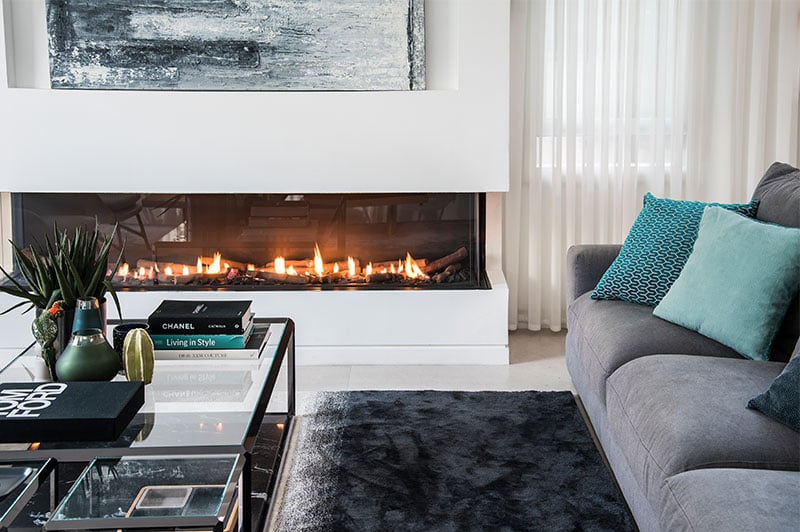Clients rely on designers to make recommendations about products based on both aesthetics and performance. When it comes to fireplaces, most people want something that not only looks great, but something that also provides functionality to keep them warm and cozy, especially in the colder months. Efficiency is also often a top priority, especially if occupants plan to use the fireplace for heat.
As a designer, you have countless options for fireplace design—so many that it can be challenging to narrow down the options. When considering whether to specify a gas versus electric fireplace, there are a few considerations to bear in mind.
Advantages of Gas vs. Electric Fireplaces
While both options offer different advantages and disadvantages, it ultimately comes down to making recommendations based on your client’s goals for the space and how they intend to use it.
The natural look of real flames
If a realistic-looking fireplace is the goal, gas is hands-down the better choice compared to an electric fireplace. A gas fireplace has real flames, and this is simply not a possibility with electric units. With gas fireplaces you can also choose the type of material beneath the flames, with styles ranging from realistic driftwood to modern glass or stones. While you have the same types of interior media options with electric fireplaces, the look of the flame will never match the real thing.
Getting cozy quicker
If your clients want a fireplace, chances are they would prefer it to provide natural heat quickly, just like a traditional wood-burning fireplace. This isn’t possible with electric fireplaces that take longer to heat up and don’t radiate as much heat as gas fireplaces can. On a chilly night, nobody wants to wait for the room to get warmer. With a gas fireplace, the heat kicks on with the flip of a switch (which also makes it more convenient than a traditional wood-burning fireplace) and quickly starts to provide comforting heat.
Reducing furnace use
Because gas fireplaces provide more radiant heat than their electric counterparts, it’s often possible to reduce furnace use through zone heating. By supplementing heat with a gas fireplace, your clients get the benefit of a stylish heat source that also allows them to save on heating bills by turning down the heat in areas that are not in use. Electric fireplaces are certainly a source of heat, but because they don’t radiate as far and the heat can’t be redirected to other areas, they aren’t as practical as a heat source.
The aesthetic advantages of real flames
When it comes to the overall design of gas versus electric fireplaces, the two options are almost equal except for one important factor: the flame. Both types of fireplaces allow you to choose different types of interior media, lighting options, mantel, surround, and other features. However, when two equivalent designs are compared side by side and the only difference is the flame, the gas fireplace will always be more aesthetically pleasing.
Ortal’s Advantages
If you do choose to specify a gas fireplace, Ortal offers advantages that will benefit your clients, including the following:
Direct venting
Direct vent gas fireplaces are safe to operate and do not impact indoor air quality. They draw combustion air from the outdoors and expel exhaust back outside through the co-axial flue. A glass front seals the system to protect room occupants and keep combustion gases from entering the indoor spaces.
Power venting
While direct vent fireplaces can be placed in a range of locations, our optional Power Vent System allows ultimate design flexibility by increasing the venting range up to 50 feet. This enables you to design fireplaces in apartments, second-floor rooms, and other areas where gas fireplaces without power venting can’t go.
Cool Wall Technology
For many clients, a fireplace isn’t the only feature they want on a wall. Whether they want to hang artwork, a television, or a sophisticated sound system, our Cool Wall Technology keeps the area above the fireplace cool enough to do it safely.
Heat barriers
All gas fireplaces require a heat barrier to prevent occupants from touching hot glass, but not all of them are aesthetically pleasing. Ortal heat barriers integrate seamlessly to maintain a sleek modern look while keeping glass at a safe temperature.
Choose Ortal Gas vs. Electric Fireplaces
Your clients trust you to make the best recommendations for their homes or commercial spaces, and the natural look of a gas fireplace has clear benefits over an electric unit, especially if you factor in Ortal’s other advantages. To learn more about all of the factors to consider when specifying a fireplace, download our free Project Planning Checklist.




